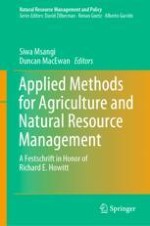2019 | OriginalPaper | Buchkapitel
12. Enhancing Productivity and Market Access for Key Staples in the EAC Region: An Economic Analysis of Biophysical and Market Potential
verfasst von : Siwa Msangi, Kennedy Were, Bernard Musana, Joseph Mudiope, Leonidas Dusengemungu, Lucas Tanui, Jean-Claude Muhutu, George Ayaga, Geophrey Kajiru, Birungi Korutaro
Erschienen in: Applied Methods for Agriculture and Natural Resource Management
Aktivieren Sie unsere intelligente Suche, um passende Fachinhalte oder Patente zu finden.
Wählen Sie Textabschnitte aus um mit Künstlicher Intelligenz passenden Patente zu finden. powered by
Markieren Sie Textabschnitte, um KI-gestützt weitere passende Inhalte zu finden. powered by
